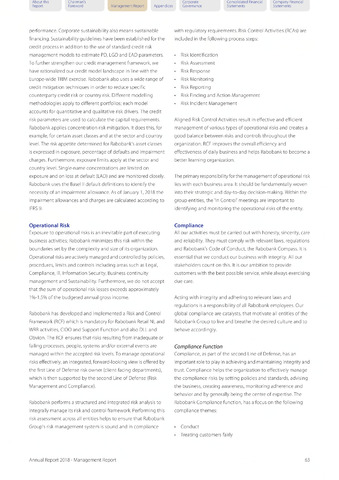About this
Report
Chairman's
Foreword
Corporate
Management Report Appendices Governance
Consolidated Financial Company Financial
Statements Statements
performance. Corporate sustainability also means sustainable
financing. Sustainability guidelines have been established for the
credit process in addition to the use of standard credit risk
management models to estimate PD, LGD and EAD parameters.
To further strengthen our credit management framework, we
have rationalized our credit model landscape in line with the
Europe-wide TRIM exercise. Rabobank also uses a wide range of
credit mitigation techniques in order to reduce specific
counterparty credit risk or country risk. Different modelling
methodologies apply to different portfolios; each model
accounts for quantitative and qualitative risk drivers. The credit
risk parameters are used to calculate the capital requirements.
Rabobank applies concentration risk mitigation. It does this, for
example, for certain asset classes and at the sector and country
level. The risk appetite determined for Rabobank's asset classes
is expressed in exposure, percentage of defaults and impairment
charges. Furthermore, exposure limits apply at the sector and
country level. Single-name concentrations are limited on
exposure and on loss at default (LAD) and are monitored closely.
Rabobank uses the Basel II default definitions to identify the
necessity of an impairment allowance. As of January 1, 2018 the
impairment allowances and charges are calculated according to
IFRS 9.
Operational Risk
Exposure to operational risks is an inevitable part of executing
business activities; Rabobank minimizes this risk within the
boundaries set by the complexity and size of its organization.
Operational risks are actively managed and control led by policies,
procedures, limits and controls including areas such as Legal,
Compliance, IT, Information Security, Business continuity
management and Sustainability. Furthermore, we do not accept
that the sum of operational risk losses exceeds approximately
1%-1.5% of the budgeted annual gross income.
Rabobank has developed and implemented a Risk and Control
Framework (RCF) which is mandatory for Rabobank Retail NL and
WRR activities, CIOO and Support Function and also DLL and
Obvion. The RCF ensures that risks resulting from inadequate or
failing processes, people, systems and/or external events are
managed within the accepted risk levels. To manage operational
risks effectively, an integrated, forward-looking view is offered by
the first Line of Defense risk owner (client-facing departments),
which is then supported by the second Line of Defense (Risk
Management and Compliance).
Rabobank performs a structured and integrated risk analysis to
integrally manage its risk and control framework. Performing this
risk assessment across all entities helps to ensure that Rabobank
Group's risk management system is sound and in compliance
with regulatory requirements. Risk Control Activities (RCAs) are
included in the following process steps:
Risk Identification
Risk Assessment
Risk Response
Risk Monitoring
Risk Reporting
Risk Finding and Action Management
Risk Incident Management
Aligned Risk Control Activities result in effective and efficient
management of various types of operational risks and creates a
good balance between risks and controls throughout the
organization. RCF improves the overall efficiency and
effectiveness of daily business and helps Rabobankto become a
better learning organization.
The primary responsibilityforthe managementofoperational risk
lies with each business area. It should be fundamentally woven
into their strategic and day-to-day decision-making. Within the
group entities, the 'In Control' meetings are important to
identifying and monitoring the operational risks of the entity.
Compliance
All our activities must be carried out with honesty, sincerity, care
and reliability. They must comply with relevant laws, regulations
and Rabobank's Code of Conduct, the Rabobank Compass. It is
essential that we conduct our business with integrity. All our
stakeholders count on this. It is our ambition to provide
customers with the best possible service, while always exercising
due care.
Acting with integrity and adhering to relevant laws and
regulations is a responsibility of all Rabobank employees. Our
global compliance are catalysts, that motivate all entities of the
Rabobank Group to live and breathe the desired culture and to
behave accordingly.
Compliance Function
Compliance, as part of the second Line of Defense, has an
important role to play in achieving and maintaining integrity and
trust. Compliance helps the organization to effectively manage
the compliance risks by setting policies and standards, advising
the business, creating awareness, monitoring adherence and
behavior and by generally being the centre of expertise. The
Rabobank Compliance function, has a focus on the following
compliance themes:
Conduct
Treating customers fairly
Annual Report 2018 - Management Report
63

